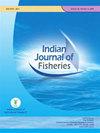Potential of enzymatically hydorlysed seaweed products as cost-effective nutrient media for growth and lipid enhancement in the marine microalga Nannochloropsis salina
IF 0.3
4区 农林科学
Q4 FISHERIES
引用次数: 0
Abstract
Enzymatically hydrolysed seaweed products (EHSPs) prepared from the red seaweed, Gracilaria corticata (EHSP-1) and brown seaweed, Stoechospermum marginatum (EHSP-2) contained abundant levels of macro, micro and trace elements necessary to fulfil the nutritional requirement of the microalga Nannochloropsis salina. EHSP-1 had higher levels of N, P, K and Fe in comparison with EHSP-2. The growth performance of N. salina suggests that EHSP-1 was more efficient than EHSP-2. The growth rate of N. salina in EHSP-1 was 1.07 times higher than the control whereas in EHSP-2 the growth rate was 0.58 times lower than the control. The maximum biomass concentration of N. salina was achieved in EHSP-1 and EHSP-2 were 0.37 and 0.21 g l-1 with a biomass productivity of 0.027 and 0.0152 g l-1 d-1 respectively. The results of biochemical analyses also suggest that protein, pigment and lipid yield of N. salina was positively stimulated by EHSP. The findings suggest that the best concentration of EHSP-1 and EHSP-2 to achieve maximum biomass and lipid production of the marine microalga N. salina were 8 and 4% respectively. EHSP-1 enhanced the biomass and lipid production without affecting the nutritional properties of N. salina suggesting its potential applicability in aquaculture, biofuel and other related industrial sectors.Keywords: Cellulase enzyme, Indigenous seaweed resources, Nannochloropsis salina, Nutrient rich media酶解海藻产品作为海洋微藻纳米绿藻生长和增脂的经济有效的营养培养基的潜力
以红色海藻、皮质龙须菜(EHSP-1)和棕色海藻、边缘石藻(EHSP-2)为原料制备的酶水解海藻产品(EHSP)含有丰富的宏、微观和微量元素,以满足微藻盐藻的营养需求。与EHSP-2相比,EHSP-1具有更高的N、P、K和Fe水平。盐生N.salina的生长性能表明,EHSP-1比EHSP-2更有效。盐生N.salina在EHSP-1中的生长速率比对照高1.07倍,而在EHSP-2中的生长速度比对照低0.58倍。在EHSP-1和EHSP-2中,盐藻的最大生物量浓度分别为0.37和0.21g l-1,生物量生产力分别为0.027和0.0152g l-1d-1。生化分析结果还表明,EHSP对盐藻的蛋白质、色素和脂质产量有积极的刺激作用。结果表明,EHSP-1和EHSP-2的最佳浓度分别为8%和4%。EHSP-1在不影响盐藻营养特性的情况下提高了盐藻的生物量和脂质产量,这表明它在水产养殖、生物燃料和其他相关工业部门具有潜在的适用性。关键词:纤维素酶;本土海藻资源;盐藻南氯藻;营养丰富的培养基
本文章由计算机程序翻译,如有差异,请以英文原文为准。
求助全文
约1分钟内获得全文
求助全文
来源期刊

Indian Journal of Fisheries
FISHERIES-
CiteScore
0.90
自引率
20.00%
发文量
0
审稿时长
6-12 weeks
期刊介绍:
Indian Journal of Fisheries is published quarterly by the Indian Council of Agricultural Research (ICAR), New Delhi. Original contributions in the field of Fish and fisheries science are considered for publication in the Journal. The material submitted must be unpublished and not under consideration for publication elsewhere.
Papers based on research which kills or damages any species, regarded as thratened/ endangered by IUCN crieteria or is as such listed in the Red Data Book appropriate to the geographic area concerned, will not be accepted by the Journal, unless the work has clear conservation objectives.
 求助内容:
求助内容: 应助结果提醒方式:
应助结果提醒方式:


